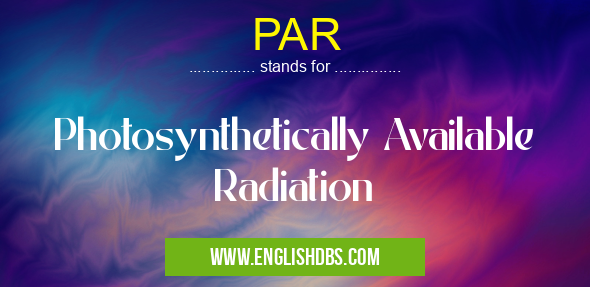What does PAR mean in UNCLASSIFIED
Photosynthetically Available Radiation (PAR) is a specific range of light wavelengths that plants can use for photosynthesis. It is a crucial factor in plant growth and development, as it provides the energy necessary for converting carbon dioxide and water into sugars and oxygen.

PAR meaning in Unclassified in Miscellaneous
PAR mostly used in an acronym Unclassified in Category Miscellaneous that means Photosynthetically Available Radiation
Shorthand: PAR,
Full Form: Photosynthetically Available Radiation
For more information of "Photosynthetically Available Radiation", see the section below.
What is PAR?
PAR is the portion of the electromagnetic spectrum that plants can utilize for photosynthesis. It ranges from approximately 400 nanometers (nm) to 700 nm, encompassing the blue, green, and red wavelengths. This range is important because it corresponds to the absorption peaks of chlorophyll a and b, the pigments responsible for capturing sunlight in plants.
Importance of PAR for Plants
PAR is essential for plant growth and productivity. It drives photosynthesis, the process by which plants convert light energy into chemical energy. This energy is used for various cellular processes, including carbon assimilation, nutrient uptake, and protein synthesis.
- Optimal PAR Levels: Different plant species have varying optimal PAR levels for photosynthesis. Generally, shade-tolerant plants can tolerate lower PAR levels, while sun-loving plants require higher levels.
- PAR and Plant Development: PAR influences various aspects of plant development, such as leaf expansion, stem elongation, and flower initiation. Adequate PAR promotes healthy growth, flowering, and fruit production.
- PAR and Yield: PAR availability directly affects crop yields. Low PAR levels can limit photosynthesis and reduce yields, while optimal PAR levels contribute to increased biomass and higher yields.
Measuring PAR
PAR can be measured using a quantum sensor or a spectroradiometer. These instruments quantify the amount of light energy available within the PAR range. Accurate PAR measurements are essential for optimizing plant growth conditions in greenhouses, growth chambers, and outdoor environments.
Essential Questions and Answers on Photosynthetically Available Radiation in "MISCELLANEOUS»UNFILED"
What is Photosynthetically Available Radiation (PAR)?
Photosynthetically Available Radiation (PAR) refers to the portion of the electromagnetic spectrum (light) that can be used by plants for photosynthesis. It encompasses wavelengths ranging from 400 to 700 nanometers, which correspond to violet-blue to orange-red light.
Why is PAR important for plants?
PAR is crucial for plant growth and development as it provides the energy that plants need to convert carbon dioxide and water into glucose through photosynthesis. This process generates the carbohydrates that plants use for growth and maintenance.
How can I measure PAR?
PAR can be measured using specialized devices called quantum sensors or PAR meters. These devices provide readings in units of micromoles per square meter per second (µmol m-2 s-1).
What is the optimal PAR range for plants?
The optimal PAR range varies depending on plant species and growth stage. However, most plants perform best under PAR levels between 500 and 1000 µmol m-2 s-1.
How can I ensure my plants are receiving adequate PAR?
To ensure adequate PAR for your plants, consider the following factors:
- Light source: Choose an artificial light source or position your plants in a location that provides ample natural sunlight.
- Distance from light source: The closer plants are to the light source, the higher the PAR they will receive.
- Light duration: Plants require a sufficient duration of PAR each day, typically 12-16 hours, to support photosynthesis.
- Leaf orientation: Position leaves perpendicular to the light source to maximize PAR absorption.
Final Words: Photosynthetically Available Radiation (PAR) is a vital factor for plant growth and development. It provides the energy for photosynthesis, driving various cellular processes and influencing plant morphology, yield, and overall health. Understanding the importance of PAR and its measurement allows growers to optimize plant growth conditions and maximize crop productivity.
PAR also stands for: |
|
| All stands for PAR |
